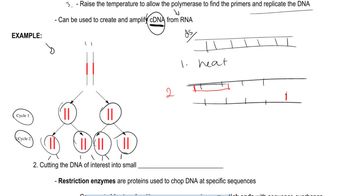Table of contents
- 1. Introduction to Genetics51m
- 2. Mendel's Laws of Inheritance3h 37m
- 3. Extensions to Mendelian Inheritance2h 41m
- 4. Genetic Mapping and Linkage2h 28m
- 5. Genetics of Bacteria and Viruses1h 21m
- 6. Chromosomal Variation1h 48m
- 7. DNA and Chromosome Structure56m
- 8. DNA Replication1h 10m
- 9. Mitosis and Meiosis1h 34m
- 10. Transcription1h 0m
- 11. Translation58m
- 12. Gene Regulation in Prokaryotes1h 19m
- 13. Gene Regulation in Eukaryotes44m
- 14. Genetic Control of Development44m
- 15. Genomes and Genomics1h 50m
- 16. Transposable Elements47m
- 17. Mutation, Repair, and Recombination1h 6m
- 18. Molecular Genetic Tools19m
- 19. Cancer Genetics29m
- 20. Quantitative Genetics1h 26m
- 21. Population Genetics50m
- 22. Evolutionary Genetics29m
15. Genomes and Genomics
Functional Genomics
Problem 9a
Textbook Question
Textbook QuestionDiscuss the advantages (and possible disadvantages) of the different approaches to reverse genetics.
 Verified Solution
Verified SolutionThis video solution was recommended by our tutors as helpful for the problem above
Video duration:
2mPlay a video:
Was this helpful?
Key Concepts
Here are the essential concepts you must grasp in order to answer the question correctly.
Reverse Genetics
Reverse genetics is a method used to understand the function of a gene by analyzing the phenotypic effects of specific gene sequences. This approach typically involves creating mutations in a gene of interest and observing the resulting changes in phenotype, allowing researchers to infer the gene's role in biological processes.
Recommended video:
Guided course

Genetic Cloning
Gene Targeting Techniques
Gene targeting techniques, such as CRISPR-Cas9 and homologous recombination, are essential tools in reverse genetics. These methods allow for precise modifications of the genome, enabling scientists to knock out, knock in, or edit specific genes. Each technique has its advantages, such as efficiency and specificity, but also potential disadvantages, including off-target effects and ethical concerns.
Recommended video:
Guided course

Mapping Genes
Phenotypic Analysis
Phenotypic analysis involves studying the observable traits or characteristics of an organism resulting from genetic modifications. This analysis is crucial in reverse genetics as it helps researchers determine the functional consequences of gene alterations. Understanding the advantages and disadvantages of different phenotypic assessment methods is vital for accurately interpreting the results of reverse genetics experiments.
Recommended video:
Guided course

Chi Square Analysis

 8:26m
8:26mWatch next
Master Functional Genomics with a bite sized video explanation from Kylia Goodner
Start learningRelated Videos
Related Practice


